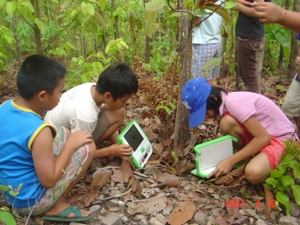User:Ndoiron/CitizenScience
Students in the One Laptop Per Child project could be using their computers to take part in citizen science projects. With written lesson plans, I can help the Cambridge Friends School and other Boston schools get started.
Citizen science brings volunteers. Such projects have gained support with the advent of the Internet, but the Audobon Society's Christmas Bird Count has been a reliable source of scientific data for over a hundred years.
Projects
The first examples which I've found, each with hundreds of reports a month:
- eBird, a North American bird watch project. Includes guides for what birds to expect and when.
- Project Budburst, a seasonal flower project. Volunteers can choose one of the popularly-tracked flowers or a local species and record the first leaves, buds, and flowers.
Please add more projects below
FAQ
Is citizen science a good fit for the laptop project?
Citizen science is ideal for laptop schools because it requires no extra equipment or technology. The laptops have built-in cameras, so photos can be uploaded to Flickr, used in school papers, and linked in reports to the project. Students 6-12 are able to make observations about nature.
What about schools (like Cambridge) in the city?
Urban schools can use a park or courtyard to track plants and birds. I recall a nature outreach program which noted that most students in the city couldn't name 10 local animal and plant species. Programs like eBird and Budburst could help foster a love of nature.
How can the laptops' technology be used for projects?
- Built-in camera (still/video)
- SocialCalc to graph results ( I intend to provide sample data sets from the projects, so they can see the projects' payoff and discover trends )
- Loading Google Maps online or through a data set
- Measure activity for sensor input into the microphone jack. Thermometers and heart rate monitors are already available.
What can I do?
Any volunteering to connect schools and citizen science is brilliantly helpful. If you could help write lesson plans, as I am doing for Project Budburst, schools connected with the One Laptop Per Child project can get started on these programs. The teachers are familiar with web browsers, spreadsheets, and word processors.
Write and link to a wiki page or e-mail a lesson plan to Ndoiron AT andrew DOT cmu DOT edu
What's the final thought?
Citizen science allows students to take part in a real experiment. It helps them to study and observe nature science them, in their backyard, the city park, or elsewhere in the community.
